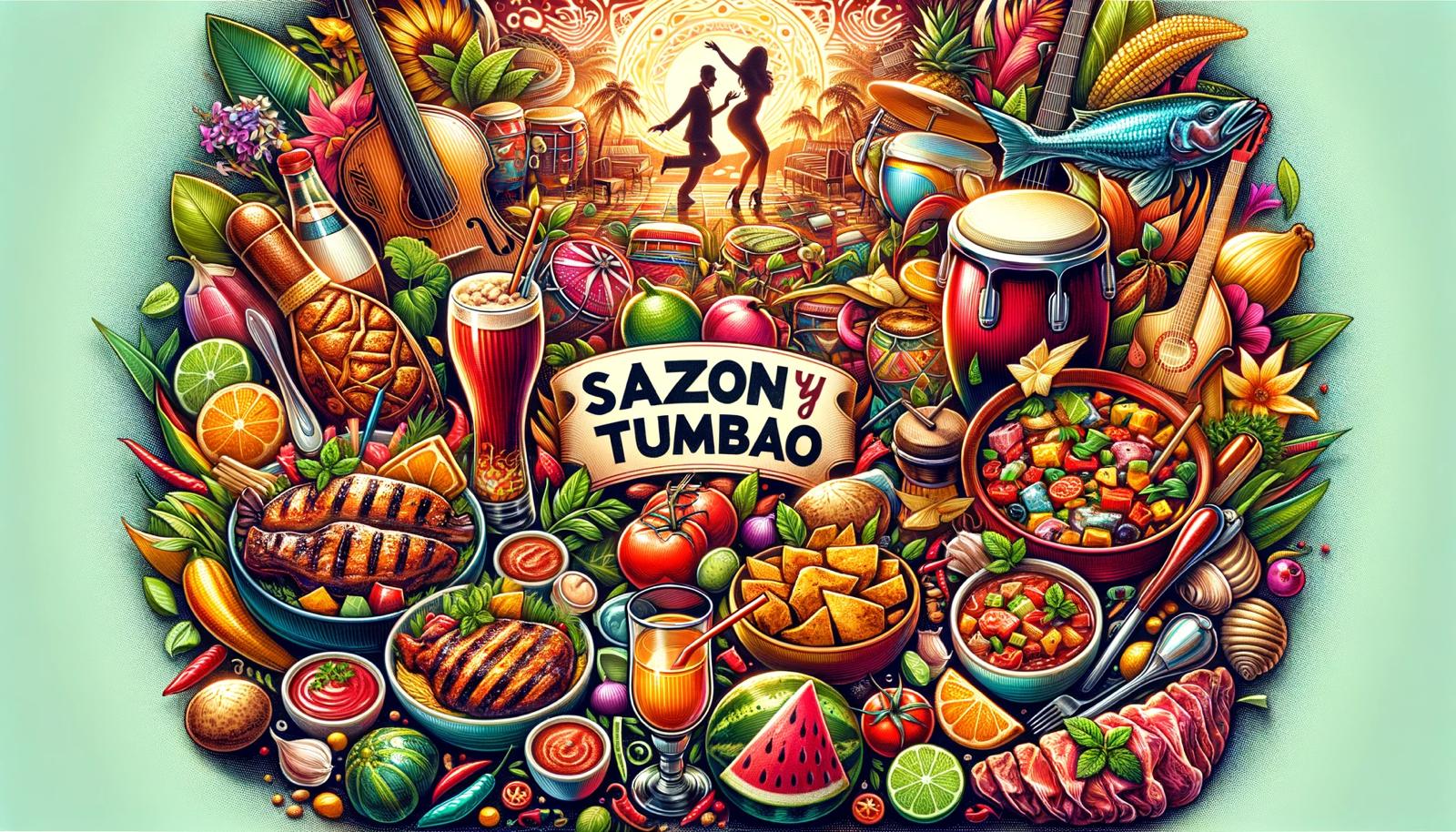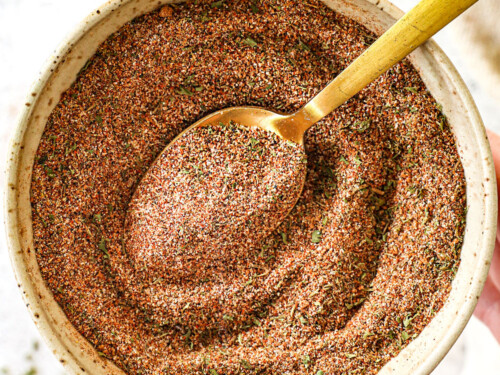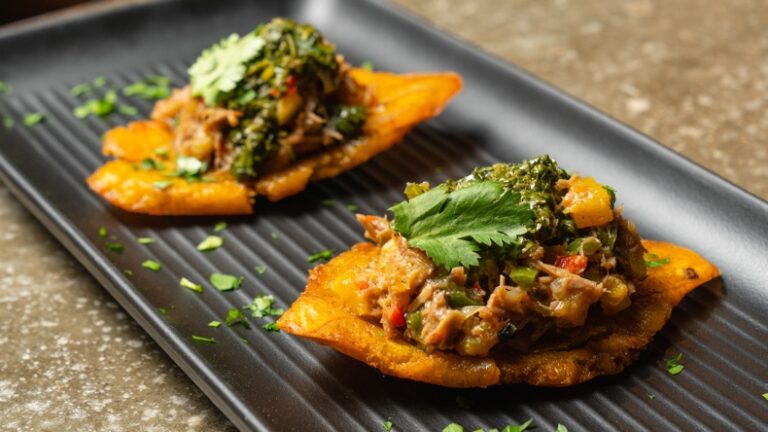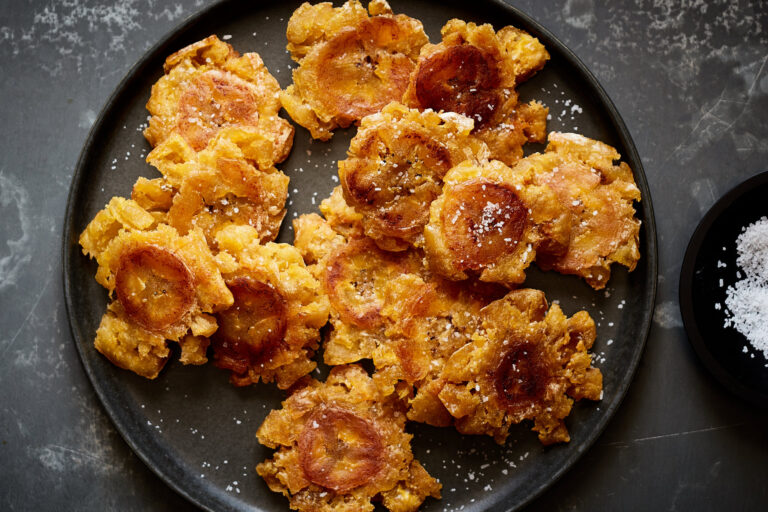Plantains, those humble tropical fruits, hold a culinary secret that transcends borders and tantalizes taste buds. In this gastronomic showdown, we pit Fufu de Plátano vs Mofongo, two iconic dishes that celebrate the plantain in distinctly delicious ways. Picture a smooth, dough-like mound on your plate, its pale golden hue hinting at sweetness.
That’s Fufu de Plátano, a beloved dish across the Caribbean and parts of Africa. The magic lies in ripe plantains, gently boiled until tender, then mashed into submission.
No fancy spices, no elaborate techniques—just pure plantain goodness. It’s the culinary equivalent of a warm hug from your abuela.
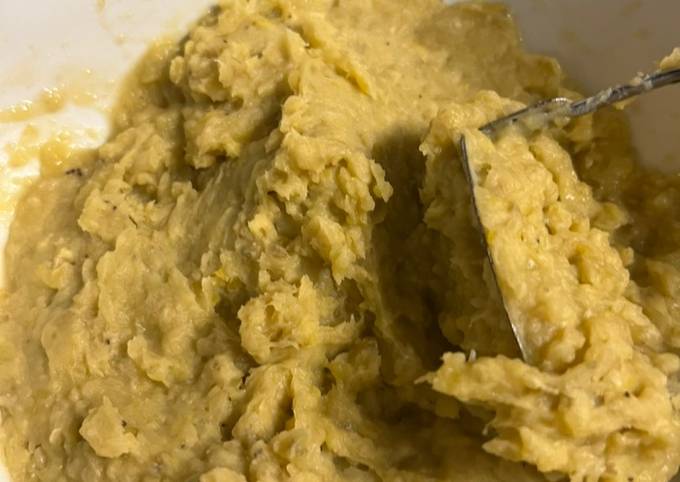
Now shift gears to the vibrant island of Puerto Rico, where Mofongo reigns supreme. Here, green plantains take center stage. They’re sliced, fried to crispy perfection, and then crushed with garlic and pork cracklings (or bacon, if you prefer). The result? A coarser, savory delight that practically sings with garlicky notes.

Mofongo isn’t just a dish; it’s a cultural anthem, echoing through family gatherings, beachside eateries, and festive celebrations. As we delve deeper, we’ll explore their ingredients, textures, and the soul-stirring stories behind these dishes. So buckle up, fellow food enthusiasts! Our journey through plantain paradise awaits.
FUFU DE PLATANO VS MOFONGO Ingredients
Fufu de Plátano:
- Ripe Plantains (Plátanos): The star of the show! Ripe plantains, with their sweet and starchy flesh, form the base of fufu. Choose plátanos that are yellow with black spots—the riper, the better.
- Water or Broth: Boil the plantains until they soften.
- Salt: A pinch of salt enhances the flavour.
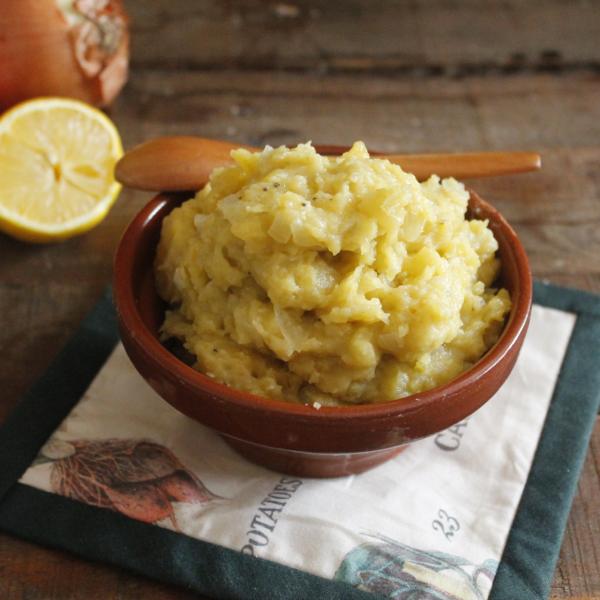
Mofongo:
- Green Plantains: Unlike their ripe counterparts, green plantains are firm and starchy. They’re the foundation of mofongo.
- Garlic: Essential for that aromatic punch.
- Pork Cracklings (Chicharrones) or Bacon: These add richness and a salty kick.
- Olive Oil: Used for frying and flavour.
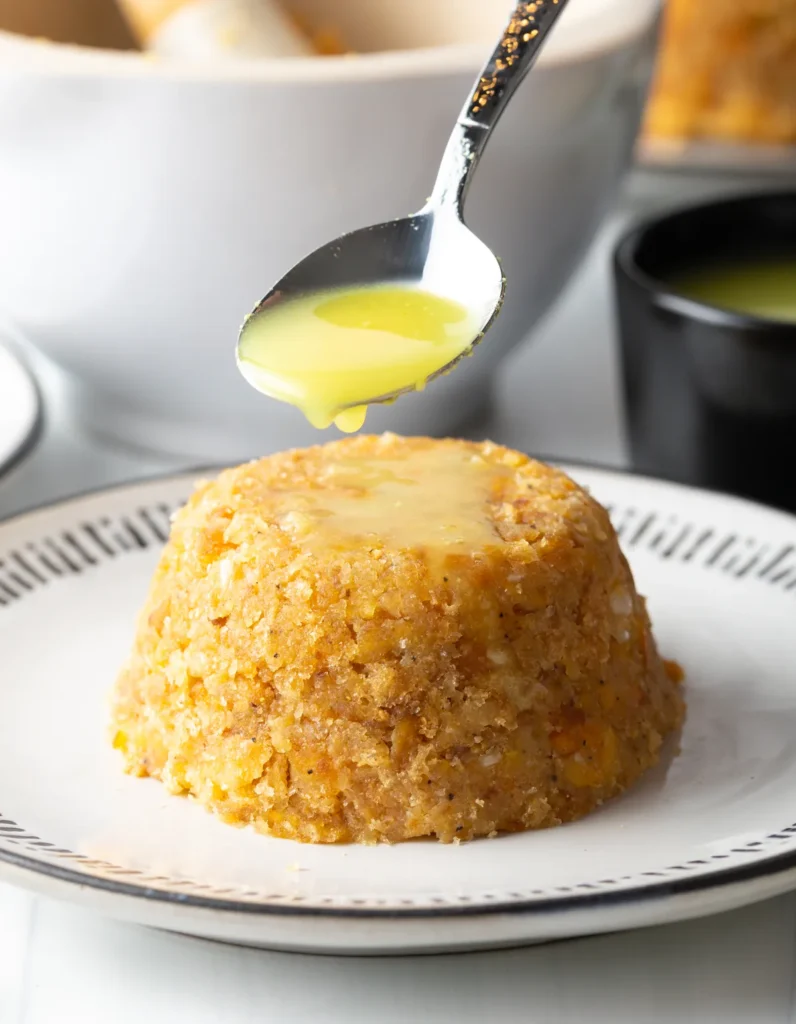
Fufu de platano vs mofongo Preparation Process
Fufu de Plátano:
- Peel and Cut: Start by peeling the ripe plantains. Slice them into chunks for easier boiling.
- Boil: Place the plantain chunks in a pot, cover with water or broth, and simmer until they’re fork-tender.
- Mash: Drain the cooked plantains and mash them into a smooth consistency. Some prefer it chunkier, while others go for silky fufu.
- Season: Add a pinch of salt to taste. Mix well.
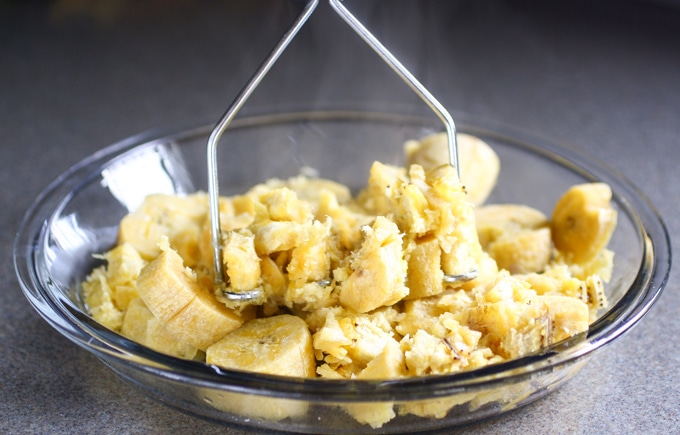
Mofongo:
- Peel and Slice: Green plantains need a firm hand. Peel them and slice them into rounds.
- Fry: Heat up some oil in a pan and fry the plantain slices until they turn golden and crispy.
- Crush and Mix: Take the fried plantains and crush them using a pilón (a wooden mortar and pestle). Add minced garlic and pork cracklings (or bacon). Keep mashing until everything combines into a cohesive mound.
- Shape: Shape the mofongo into a ball or mound. Some variations include stuffing it with meat or seafood.
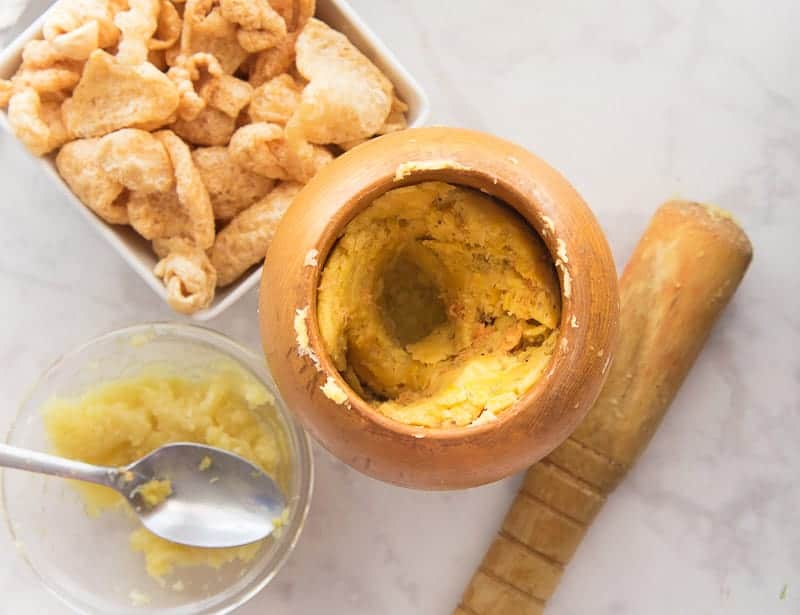
These two dishes may share a common ingredient—plantains—but their paths diverge into distinct culinary territories.
Texture and Flavor FUFU DE PLATANO VS MOFONGO
Fufu de Plátano:
- Texture:
- Smooth and Dough-Like: Imagine a velvety mound on your fork. Fufu de plátano achieves this texture through thorough mashing of ripe plantains. It’s akin to edible clouds, soft yet substantial.
- Flavor:
- Mildly Sweet: Ripe plantains bring a gentle sweetness to the party. It’s not overpowering; rather, it complements savoury dishes beautifully. Think of it as a subtle dance between starch and sugar.
Mofongo:
- Texture:
- Coarser and Rustic: Mofongo takes a different path. The fried green plantains lend a coarser texture. You’ll encounter delightful bits of crispy goodness as you dig in.
- Flavor:
- Garlicky Savory: Mofongo doesn’t hold back. Garlic infuses every bite, creating a robust flavour profile. Add in the pork cracklings (or bacon), and you’ve got a symphony of savoury notes.
Serving Variations
Fufu de Plátano:
- Common Pairings:
- Stews and Soups: Fufu de plátano cosies up to hearty stews and soul-warming soups. Its mild flavour acts as a perfect canvas for soaking up rich broths.
- Grilled Meats: Picture a plate with fufu alongside juicy grilled chicken, beef, or fish. The contrast between the smooth fufu and the charred meat is delightful.
- Cultural Context:
- Caribbean and African Traditions: Fufu transcends borders. In the Caribbean, it’s a staple at family gatherings and celebrations. In African cuisines, it’s a comforting side dish that brings people together.
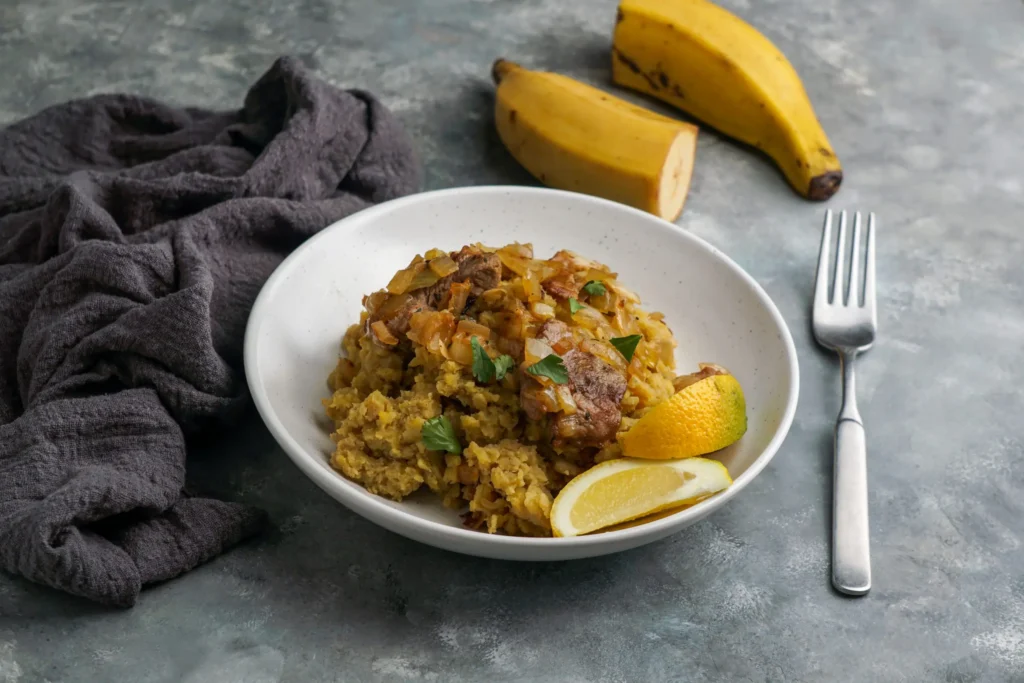
Mofongo:
- Main Course or Side Dish:
- Mofongo isn’t shy—it can be the star of the meal or a trusty sidekick. It all depends on how you serve it.
- Protein Partners: Mofongo often shares the spotlight with proteins like shrimp, chicken, or beef. Imagine a mound of garlicky mofongo crowned with succulent grilled shrimp.
- Iconic in Puerto Rico:
- Beachside Eateries and Festivals: When you’re in Puerto Rico, mofongo is everywhere. From beachside kiosks to family-run restaurants, it’s a taste of the island’s heart and soul.
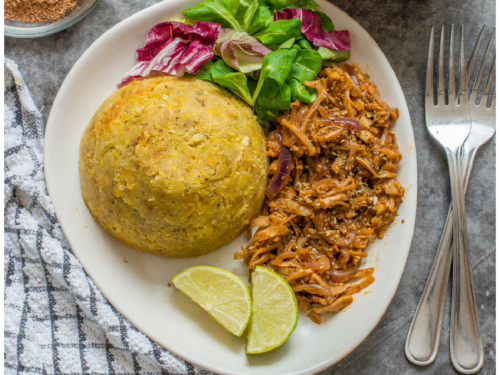
Cultural Significance
Fufu de Plátano:
- Caribbean and African Roots:
- Fufu de plátano has deep roots in both Caribbean and African culinary traditions.
- In the Caribbean, it’s a dish that graces family gatherings, Sunday lunches, and festive celebrations. It’s the taste of home—the warm embrace of generations.
- Across Africa, variations of fufu are staples. Whether it’s pounded yam in Nigeria or fufu in Ghana, the process of mashing starchy ingredients transcends borders.
- Symbol of Togetherness:
- Fufu isn’t just food; it’s a communal experience. Picture a large bowl of fufu placed at the centre of the table. Family members gather around, tearing off pieces and dipping them into flavorful stews.
- The act of sharing fufu symbolises unity, love, and the ties that bind us. It’s a reminder that no matter where we are, our shared meals connect us.
Mofongo:
- Puerto Rico’s Culinary Anthem:
- Mofongo isn’t just a dish; it’s a cultural anthem in Puerto Rico. It’s the rhythm of the island, the beat of its heart.
- From beachside kiosks to bustling city restaurants, mofongo is omnipresent. Locals and visitors alike savour its garlicky goodness.
- Celebrations and Traditions:
- Birthdays, weddings, holidays—mofongo graces every occasion. It’s the guest of honour, sitting proudly on plates adorned with colourful sauces and succulent meats.
- During festivals, the air fills with the aroma of frying plantains, and mofongo becomes a shared joy—a taste of Puerto Rico’s vibrant spirit.
These dishes aren’t just about sustenance; they’re woven into the fabric of culture and memory. As you explore their flavors, remember the hands that shaped them and the laughter shared over steaming plates.
Final Analysis
As our culinary journey through plantain paradise comes to an end, we’ve explored the clash of flavors, textures, and cultural tales surrounding Fufu de Plátano vs Mofongo. These dishes aren’t mere recipes; they’re vessels of memory, tradition, and shared joy.
Next time you encounter a plate of fufu or a mound of mofongo, remember the hands that shaped them—the abuelas stirring pots, the beachside chefs flipping plantains, and the laughter echoing across family tables.
So go ahead and savor the taste of history. Let the warmth of these dishes wrap around you like a familiar hug. And as you take that first bite, know that you’re partaking in a timeless dance—one that transcends borders and connects us all.
